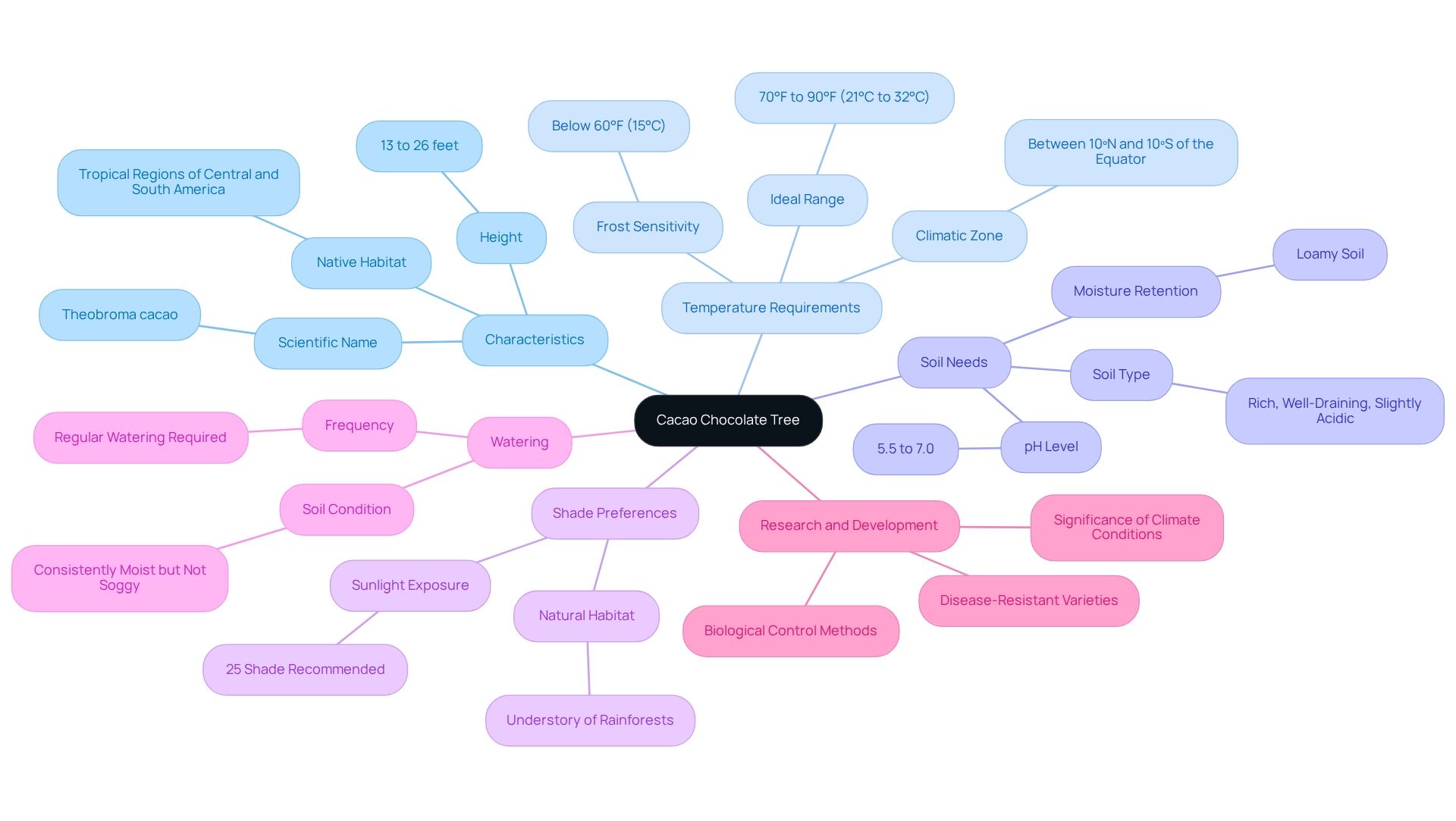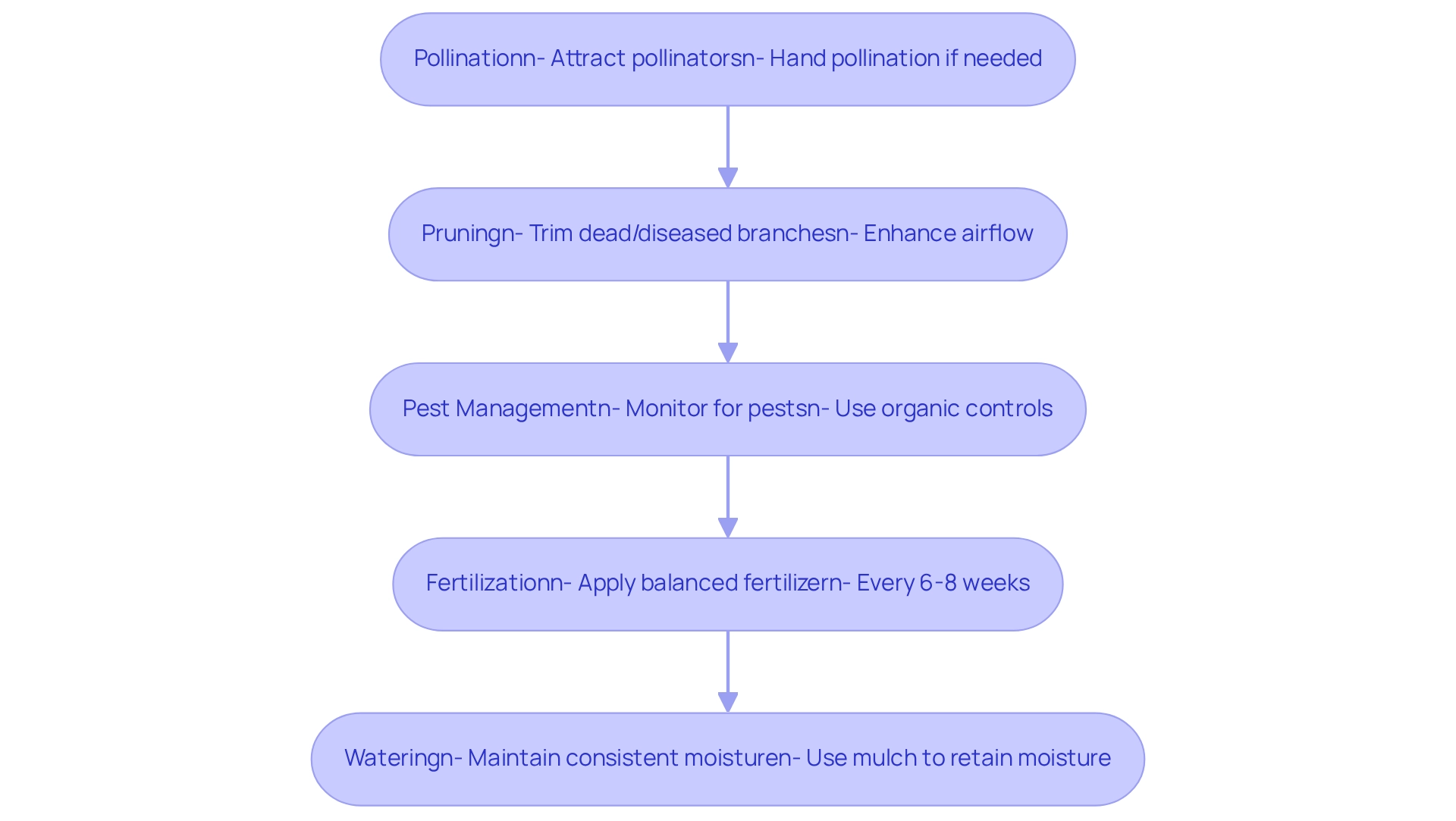-
Criollo Cacao Chocolate Tree – Rare and prized for its fine flavor
-
Forastero Cacao Tree – Hardy and productive
-
Trinitario Cacao Red Pods – A hybrid with good yield and flavor
-
Trinitario Cacao Yellow Pods – Mild and fruity
-
Nacional Cacao Tree – Rare heirloom, complex notes
-
Chocolate Tree Red – Stunning red pods, vibrant addition to any garden
🌿 All available now at Everglades Farm, ready to ship directly to your door.
1. Understand the Cacao Tree: Characteristics and Requirements
- Watering: Regular watering is vital, especially during dry spells. The soil should remain consistently moist but not soggy to ward off root rot.

🌱 Looking for a special tropical addition to your garden? The Trinitario Cacao Yellow Chocolate Tree or the Criollo Cacao Chocolate Tree are excellent picks — beautiful, rare, and perfect for warm climates.
2. Prepare for Planting: Location, Soil, and Seed Selection
-
Choose the Right Location: Begin by selecting a site that receives partial shade and is shielded from strong winds. Ideally, this area should be near taller plants that can offer natural shade, as cocoa plants thrive in such environments. Picture a typical forest of cacao chocolate trees, composed of 75% cacao chocolate trees and 25% shade trees—this highlights just how vital shade is for cacao cultivation.
-
Ground Preparation: Next, assess the pH of the soil, aiming for a slightly acidic range of 5.5 to 7.0. You may need to modify the ground by incorporating organic matter like compost or well-decomposed manure, which can enhance fertility and drainage. This not only improves soil quality but also aligns with sustainable farming practices, similar to successful agroforestry systems.
-
Seed Selection: When it comes to choosing seeds, opt for healthy chocolate seeds from reputable suppliers. Look for seeds from the cacao chocolate tree that are plump and free from blemishes, preferably harvested from ripe cacao pods, which usually have higher germination rates.
-
Planting Depth: When sowing your seeds, bury them abou 1 inch deep in the soil. It's important to keep the ground moist, but not waterlogged, to encourage healthy growth.
- Spacing: If you're planting several saplings, be sure to maintain a distance of at least 10-15 feet between them. This spacing allows for adequate growth and airflow, which is essential for preventing disease and ensuring robust development.
By carefully choosing the right site, preparing the soil, and selecting premium seeds for the cacao chocolate tree, you lay the groundwork for a flourishing plant. Historical methods, such as the Cabruca agroforestry technique in Brazil, illustrate the benefits of integrating cocoa plants with indigenous species, fostering biodiversity while enhancing crop yields. For instance, Dengo chocolate, crafted using the Cabruca system, exemplifies sustainable cocoa farming that supports both biodiversity and local economies. Embracing these best practices not only nurtures the health of your cocoa trees but also contributes to sustainable gardening initiatives. As Caio Carvalho, president of the Brazilian Agribusiness Association, aptly noted, "It is madness, an aggressive and unmeasured posture" regarding current chocolate farming practices. This underscores the urgent need for sustainable methods in our sector.
3. Plant and Nurture: Germination to Transplanting
- Germination Conditions: It's essential to keep the substrate consistently warm, around 80°F or 27°C, while maintaining high humidity. Covering the pots with plastic wrap or a humidity dome can help retain moisture. Research shows that cacao chocolate tree seedlings under moderate shade achieved an impressive pod yield of 97.6% during the first main crop harvest. This highlights just how crucial optimal growing conditions are for your plants.
- Gently water the seeds to keep the ground damp, but avoid making it soggy. Remember, overwatering can lead to rot, so ensuring proper drainage is key.
- Light Requirements: Position the pots in a spot with indirect sunlight, as direct sunlight can be too harsh for young seedlings.
- Monitoring Growth: Germination typically takes about 2-3 weeks. Once your seedlings have developed several leaves and reached about 6 inches tall, they are ready for transplanting.
- Transplanting: When it’s time to transplant, choose a cloudy day or late afternoon to minimize stress on your seedlings. Dig a hole that is three times the diameter of the root ball and gently place the seedling in the hole, covering the roots with soil. You might also consider sustainable techniques, like incorporating Trichoderma spp. as biostimulants, which can enhance cocoa productivity while promoting environmentally friendly practices.
By providing the right conditions during sprouting and carefully relocating your young plants, you will ensure a strong start for your cacao chocolate tree. As Karen Brooks beautifully expressed, "These are taken from inside the fruit of the chocolate plant-- it means 'food of the gods.'" In your hands, you hold something akin to ambrosia—an ambrosia we turn into nectar. This sentiment underscores the importance of cultivating cocoa plants not only for their yield but also for the joy they bring into our lives.
👉🏻 We make it easy to grow cacao at home. All our cacao trees — including the rare Nacional Cacao Chocolate Tree — are shipped directly to your door with care. Start your chocolate-growing journey today.
4. Maintain and Care: Pollination, Pruning, and Pest Management
- Pollination: Cacao chocolate trees rely on cross-pollination for fruit production, and attracting essential pollinators like midges can be a delightful part of your gardening journey. Consider planting companion plants nearby to create a welcoming environment. If natural pollination isn’t sufficient, don’t worry—hand pollination can be a rewarding alternative. Simply use a small brush to transfer pollen between flowers, ensuring optimal fertilization rates.
- Pruning: Regular trimming is crucial for maintaining your plant's shape and promoting healthy growth. As you care for your cacao, take a moment to remove any dead or diseased branches and thin out crowded areas to enhance airflow. Pruning during the dry season is advisable, as it minimizes stress on the plant, which can significantly impact yield.
- Pest Management: Keeping a vigilant eye on your cacao plant for pests such as mealybugs and aphids is essential. Employing organic pest control methods, including neem oil or insecticidal soap, can help you manage infestations effectively. Regular examinations of leaves and stems for signs of pests or disease are crucial for preserving your plant's health.
- Fertilization: Providing essential nutrients is key to your plant's vitality. Applying a balanced fertilizer every 6-8 weeks during the growing season will support its growth. Choose fertilizers specifically designed for fruit-bearing plants to ensure optimal results.
- Watering: Consistent moisture is vital, especially during dry spells. Mulching around the base of the plant can aid in retaining soil moisture and suppressing weeds, contributing to overall health. By implementing these maintenance practices, you will significantly enhance the vitality and productivity of your cacao chocolate tree, paving the way for a successful harvest. Remember, every step you take in caring for your cacao plant brings you closer to enjoying the fruits of your labor!

💡 The key to healthy cacao trees is consistent care. Whether you're growing the Forastero Cacao Tree or the bold Chocolate Tree Red, watering and pest control make all the difference.
5. Harvest and Process: From Pod to Chocolate
- Harvesting Pods: With a sharp knife or machete, carefully [cut the ripe pods](https://anangtawiah.com/articles/details/The Ghana Cocoa Report 2024: Cocoa Harvesting in Ghana: Challenges, Efficiency, and Future Strategies-206) from the plant. It’s important to do this gently to minimize damage to the surrounding flowers and branches. Remember, having the right tools makes all the difference. Typically, we harvest from the cacao chocolate tree twice a year, in harmony with the tree's flowering cycle.
- Opening Pods: After harvesting, use your machete to slice the pods of the cacao chocolate tree in half and extract the cacao seeds along with the surrounding pulp. This step is crucial for obtaining the ingredients we need for chocolate production.
- Fermentation: Place the extracted seeds and pulp into a container and cover them with banana leaves. Allow this mixture to ferment for 5-7 days, turning it occasionally. This process is essential for enhancing the rich flavors of the seeds. For Criollo varieties, just 2-3 days of fermentation can make all the difference in taste.
- Drying: Spread the seeds in the sun to dry for several days until they’re completely moisture-free. Keeping the drying temperatures under 65ºC is crucial to avoid mold and ensure the seeds’ quality. If you prefer, you can also use artificial drying methods with wood and fuel dryers to achieve the desired moisture content.
- Roasting and Grinding: Roast the dried beans at a low temperature to enhance their flavor profile. Once roasted, remove the shells and grind the nibs into a paste. This paste can be further refined into chocolate by incorporating sugar and other delightful ingredients.






0 comments